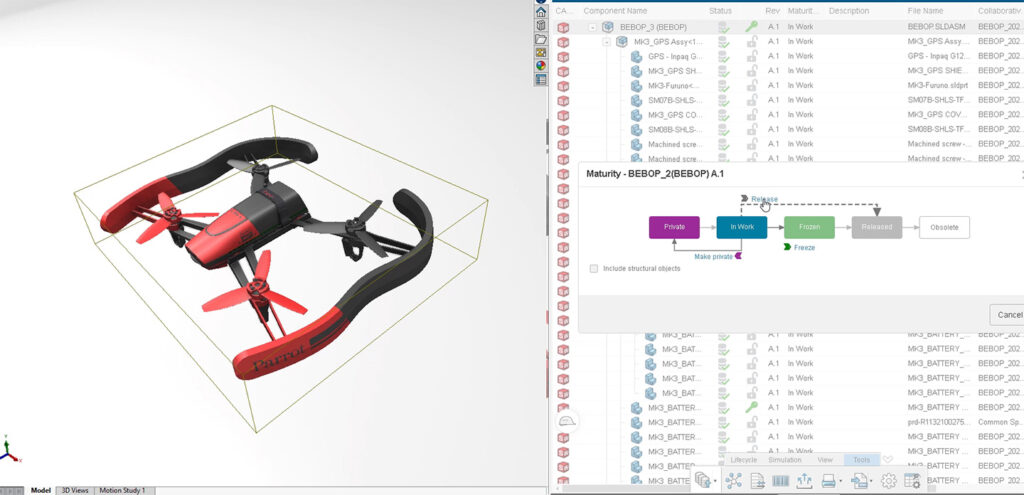Navigating the Pathways of Collaboration: A Comprehensive Exploration of Data Management and Collaboration Tools in SolidWorks

Data management and collaboration stand as essential pillars in the realm of engineering design, enabling teams to effectively manage, share, and collaborate on design data and project information. In this extensive exploration, we delve into the intricacies of data management and collaboration tools in SolidWorks, uncovering their functionalities, benefits, and practical applications across diverse industries and disciplines.
Understanding Data Management and Collaboration in SolidWorks:
Data management and collaboration in SolidWorks encompass a suite of integrated tools and workflows designed to streamline the management, sharing, and collaboration of design data and project information within a collaborative environment. By leveraging these tools, teams can efficiently organize, access, and control design data, ensuring version control, data integrity, and traceability throughout the product lifecycle.
At its core, data management and collaboration in SolidWorks empower teams to collaborate seamlessly across departments, locations, and disciplines, facilitating communication, coordination, and alignment throughout the design and development process. By providing centralized access to design data, revision control, and collaboration features, SolidWorks enables teams to work together effectively, accelerating decision-making, reducing errors, and improving overall productivity.
Key Concepts of Data Management and Collaboration in SolidWorks:
- File Management and Version Control: SolidWorks provides robust file management and version control capabilities, enabling teams to organize, store, and manage design files, documents, and project data within a centralized repository. Designers can check files in and out, create versions and revisions, and track changes and updates, ensuring data integrity and traceability throughout the design process.
- Collaborative Workspaces: SolidWorks facilitates collaborative workspaces where teams can collaborate on design projects in real-time, regardless of location or time zone. Designers can share design data, documents, and annotations, collaborate on design reviews and markups, and communicate seamlessly within a collaborative environment, enhancing teamwork and productivity.
- Task Management and Workflow Automation: SolidWorks includes tools for task management and workflow automation, enabling teams to streamline design processes, assign tasks, and track progress throughout the project lifecycle. Designers can create workflows, define milestones and deliverables, and automate notifications and approvals, ensuring transparency and accountability in project management.
- Integration with Product Lifecycle Management (PLM) Systems: SolidWorks integrates seamlessly with Product Lifecycle Management (PLM) systems, enabling teams to leverage enterprise-wide data management and collaboration capabilities. Designers can synchronize design data, workflows, and processes between SolidWorks and PLM systems, ensuring consistency, compliance, and governance across the organization.
Benefits of Data Management and Collaboration in SolidWorks:
- Enhanced Team Collaboration: SolidWorks fosters enhanced team collaboration by providing centralized access to design data, collaborative workspaces, and communication tools. Teams can collaborate seamlessly across departments and disciplines, share ideas, and resolve issues in real-time, improving teamwork, communication, and alignment.
- Improved Productivity and Efficiency: Data management and collaboration tools in SolidWorks enhance productivity and efficiency by streamlining design processes, automating workflows, and reducing manual tasks and errors. Designers can access design data instantly, track project progress, and collaborate effectively, reducing cycle times and improving overall efficiency.
- Data Integrity and Traceability: SolidWorks ensures data integrity and traceability by providing robust version control, revision management, and audit trail capabilities. Designers can track changes, revisions, and approvals throughout the design process, ensuring compliance with regulatory requirements and industry standards.
- Streamlined Decision-Making: SolidWorks facilitates streamlined decision-making by providing access to real-time design data, analytics, and insights. Designers can analyze design performance, simulate scenarios, and evaluate alternatives, enabling informed decision-making and risk mitigation throughout the product lifecycle.
Practical Applications of Data Management and Collaboration in SolidWorks:
- Product Design and Development: SolidWorks supports product design and development applications by providing robust data management and collaboration capabilities. Design teams can collaborate on design projects, share design data, and manage design iterations and revisions, ensuring seamless coordination and alignment throughout the product development process.
- Engineering Change Management: SolidWorks facilitates engineering change management by providing tools for tracking and managing design changes and revisions. Designers can initiate change requests, assess impact analysis, and implement changes systematically, ensuring compliance with change control processes and regulatory requirements.
- Supply Chain Collaboration: SolidWorks enables supply chain collaboration by providing tools for sharing design data and specifications with suppliers and manufacturing partners. Designers can collaborate with suppliers on design reviews, provide feedback on manufacturability, and streamline procurement processes, enhancing collaboration and efficiency across the supply chain.
- Regulatory Compliance and Documentation: SolidWorks supports regulatory compliance and documentation by providing tools for managing design documentation, certifications, and approvals. Designers can generate documentation such as bills of materials (BOMs), specifications, and compliance reports, ensuring compliance with regulatory standards and requirements.
Conclusion:
Data management and collaboration in SolidWorks represent essential enablers of innovation, productivity, and efficiency in engineering design and product development. By providing centralized access to design data, collaborative workspaces, and workflow automation capabilities, SolidWorks empowers teams to collaborate seamlessly, streamline processes, and make informed decisions throughout the product lifecycle. Whether used in product design, engineering change management, supply chain collaboration, or regulatory compliance, data management and collaboration in SolidWorks enable teams to navigate the pathways of collaboration, communication, and excellence in engineering and manufacturing.







